
Edward Winter
What is Anastasia’s mate? Most of the encyclopaedias do not even have an entry for it, while those that do are contradictory. Brace says that it is ‘a mate of a castled K following the sacrifice of the queen for a pawn’, gives an illustrative position and says that this combination appeared in the novel Anastasia und das Schachspiel, Briefe aus Italien (1803) by Wilhelm Heinse.
The Dictionnaire des échecs, however, has other (more complicated) ideas:
‘Manoeuvre de partie consistant à sacrifier une pièce blanche (ou noire) A pour provoquer la déviation d’une pièce noire (ou blanche) B, écart de cette pièce entraînant un passage dont une D blanche (ou noire) C profite pour administrer un mat en deux coups au R noir (ou blanc) à bande.’
Le Lionnais and Maget then give an illustrative game (Betbeder-Tyroler, Hamburg Olympiad, 1930) in which there is no question of a castled king or a queen sacrifice.
And now the September [1983] Chess Life publishes (page 56) the following game in which ‘a master falls into a form of Anastasia’s mate’:
R. Lemon – M. Plum (seriously)
US Open, St Paul 1982
Scotch Game
1 e4 e5 2 Nf3 Nc6 3 d4 exd4 4 Nxd4 Bc5 5 Be3 Qf6 6 c3 Nge7 7 Nc2 Bxe3 8 Nxe3 d6 9 Bc4 Be6 10 Nd2 Ne5 11 Be2 O-O-O 12 O-O g5 13 Qa4 Kb8 14 Rad1 N7g6 15 Nd5 Bxd5 16 exd5 Nf4 17 Qe4 Qg6 18 Bb5 a6 19 Qxg6 hxg6 20 Bc4 Nxc4 21 Nxc4

21...Ne2+ and Black announced mate in two moves: 22 Kh1 Rxh2+ 23 Kxh2 Rh8 mate.
(576)
Frank Skoff (Chicago, IL, USA) writes:
‘Anastasia’s mate is basically a R & N mate, as exemplified in Lemon v Plum; the N controls g1 and g3 and the R the squares h1-2-3. Clearly this theme can occur in the centre of the board, although obviously it has more frequency in a corner. Chapter five of Renaud and Kahn’s The Art of the Checkmate is devoted to it, the mate against the castled king being dubbed “Anastasia’s mate”, citing the Heinse novel. It also has two diagrams, A & B, to indicate slight variants: in A, the mate is against the castled K à la Anastasia; but B shows an almost identical mate in the centre of the board, the K protecting the N (from KxN by Black) and also holding two squares from Black’s possible escapes. Thus, White with K e3, N f3 and R g1, Black with K g3, P h3. The mate is unchanged if the position is moved to any central area of the board.
Of course, since a Q includes the power of the R, what happens if the attacker sacrifices with RxKRPch (in the castled K position by Black with the White N at K7) and then mates with the Q? The Betbeder game would not fit Renaud and Kahn’s groupings and it is certainly not Anastasia’s mate as cited in Heinse. Renaud and Kahn would call it Damiano’s mate: here White could mate with his Q but his R is in front; so he sacrifices the R, allowing the Q to check protected by a pawn and mate with the aid of the same pawn. In Betbeder there is a line clearance when Black plays BxR (after White’s R-KB8ch) but that has hardly anything in common with the so-called Anastasia.’
A simple case of Anastasia’s mate:
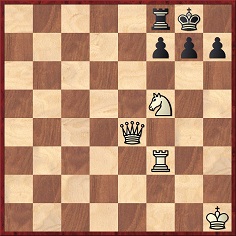
White to move
1 Ne7+ Kh8 2 Qxh7+ Kxh7 3 Rh3 mate.
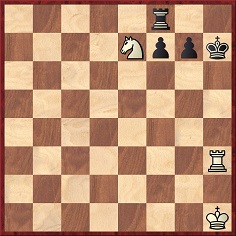
Below, however, are some complications.
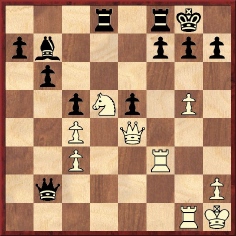
White to play and win
At first glance it may appear that White can win at once with any of the following:
However, all these standard mating combinations are impossible because of the pin on the a8-hl diagonal, and the winning course is therefore the prosaic 1 Ne7+ and 2 Qxb7.
The position was discussed in C.N.s 741 and 796 (see page 1 of Kings, Commoners and Knaves), being taken from an article on chess blindness by Josef Krejcik on page 14 of the March 1923 Wiener Schachzeitung. Krejcik stated that the position had occurred in a game played by him, as White, against a well-known grandmaster in 1907, and he gave more or less the same text on pages 16-17 of his book 13 Kinder Caïssens (Vienna, 1924).
Here, though, we add a complication. On pages 189-191 of How to Play Chess Like a Champion (New York, 1956) Fred Reinfeld discussed a similar position:
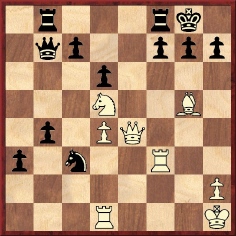
Reinfeld stated that this position arose in ‘a game played by two Viennese amateurs many years ago’ and that Maróczy was a spectator. White could win a pawn with 1 Nxc3 bxc3 2 Qxb7 Rxb7 3 Rxc3 but, Reinfeld said, would have difficulty in winning and therefore had the idea 1 Ne7+ Kh8 2 Qxh7+ Kxh7 3 Rh3 mate. Then White realized that the rook was pinned, but at this point Maróczy exclaimed ‘Magnificent’. Consequently, White looked for a finesse and found 3 d5 Qc8 4 Rd4 g6 5 Bf6 g5 6 Rdd3 g4 7 Rd4 Ne4 8 Rxe4 Qf5 9 Rh3+ gxh3 10 Rh4+ Qh5 11 Rxh5 mate.
Reinfeld then wrote:
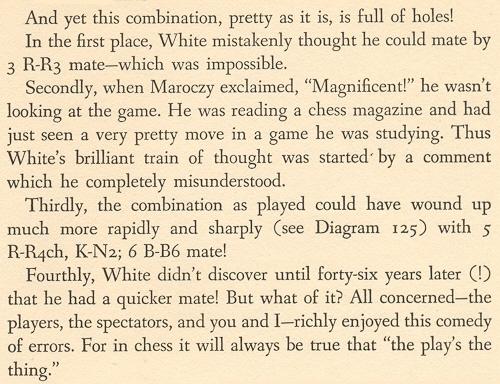
What was Reinfeld’s source for this story?
(4888)
Peter Anderberg points out that Reinfeld’s account is a summary of an article by Josef Krejcik entitled ‘Ein einmaliger Partieschluß’ on page 179 of the 11/1953 Schach-Echo. Krejcik stated that he won the game from Jakob Bendiner in March 1907 and that Maróczy’s comment ‘magnificent!’ (‘prächtig’) was prompted by a problem of Pauly’s in the Deutsches Wochenschach. Page 212 of the 13/1953 Schach-Echo reported that several readers had noted the faster mate 5 Rh4+ Kg7 6 Bf6.
We cannot explain why Krejcik gave two different positions or why, on page 14 of the March 1923 Wiener Schachzeitung, he described his opponent as ‘a well-known grandmaster’.
(4898)
To the Chess Notes main page.
To the Archives for other feature articles.
Copyright: Edward Winter. All rights reserved.